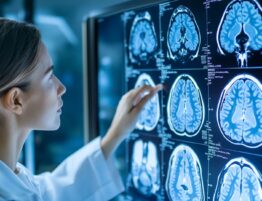Parkinson’s disease is a progressive neurological disorder that affects movement and much more. The condition develops when dopamine-producing cells in the substantia nigra, a brain region responsible for controlling smooth movement, gradually die off. As dopamine levels drop, the brain struggles to send proper signals to muscles, leading to the characteristic movement problems associated with the disease.
Parkinson’s symptoms typically start subtly. A resting tremor may appear in one hand, muscle stiffness slows down daily tasks, and bradykinesia (slow movement) makes simple actions feel sluggish. Balance problems develop over time, but movement issues aren’t the only concern. Non-motor Parkinson’s symptoms often emerge early in the disease process, including sleep disturbances, mood changes, and chronic constipation that can signal the onset of Parkinson’s years before motor symptoms appear.
The disease impacts the central nervous system in complex ways. Abnormal alpha-synuclein proteins clump together into structures called Lewy bodies, which damage nerve cells beyond just the dopamine-producing areas. This widespread damage weakens autonomic functions and may lead to cognitive decline in later stages of the disease. While no cure currently exists, treatments can effectively manage symptoms, and early detection significantly enhances the effectiveness of treatment.
Neurologists diagnose Parkinson’s through motor tests and thorough medical history, sometimes using specialized imaging to rule out conditions that mimic Parkinson’s. Awareness of warning signs is crucial for preserving quality of life. If you notice potential symptoms, seeking prompt medical evaluation can make a substantial difference in long-term outcomes.
Motor Symptoms of Parkinson’s Disease
The most recognizable symptoms of Parkinson’s disease involve movement problems. Tremor often begins in one hand and is most noticeable at rest, with the classic “pill-rolling” motion between thumb and fingers being a hallmark sign. Stress typically worsens tremors, while sleep reduces them. Rigidity, or muscle stiffness, affects the limbs and trunk, causing muscles to remain tense and making movements feel locked or difficult. When rigidity combines with tremor, it creates “cogwheel rigidity,” a ratcheting sensation doctors can feel during examination.
Bradykinesia, or slow movement, progressively slows down all actions. Steps become shorter, facial expressions fade into a masked appearance, handwriting becomes smaller and more cramped, and daily tasks that were once automatic now require conscious effort and take much longer to complete.
Common Parkinson’s symptoms include:
- Tremor: Shaking at rest, often starting on one side of the body
- Rigidity: Muscle stiffness with a lead-pipe or cogwheel quality
- Bradykinesia: Reduced speed and smaller movements
- Postural instability: Stooped posture with balance problems emerging in later stages
- Gait changes: Shuffling steps with reduced arm swing while walking
- Speech difficulties: Voice becomes softer and more monotone
- Facial changes: Reduced facial expression and decreased blinking
- Loss of dexterity: Activities like buttoning shirts or brushing teeth become slow and difficult
Parkinson’s diagnosis relies primarily on clinical observation since no single test can definitively confirm the condition. Doctors observe these motor signs during physical examinations. DaTscan imaging, which shows dopamine activity in the brain, can support clinical findings. A positive response to levodopa medication also helps confirm the diagnosis.
Early Parkinson’s signs may mimic other conditions like essential tremor or vascular Parkinsonism. Neurologists typically use the UK Brain Bank criteria, which require the presence of bradykinesia plus at least one other cardinal motor feature (tremor or rigidity). Symptoms appearing more severely on one side of the body (asymmetry) strengthens the diagnosis. Non-motor clues, such as loss of smell, add important diagnostic context.
Diagnosing Parkinson’s demands expertise, and misdiagnosis occurs in approximately 20% of cases, particularly when evaluated by non-specialists. Regular follow-up appointments help track disease progression and refine diagnostic accuracy over time.
Non-Motor Symptoms of Parkinson’s
Non-motor Parkinson’s symptoms significantly affect quality of life and often appear years before motor problems become noticeable. Sleep problems are widespread, with REM behavior disorder causing people to act out their dreams during sleep. Insomnia makes it difficult to fall asleep, and poor nighttime rest can lead to excessive daytime sleepiness.
Depression affects about 50% of Parkinson’s patients, lowering mood and reducing motivation. Apathy decreases interest in previously enjoyed activities, and anxiety creates persistent worry and tension. Cognitive decline typically starts subtly, with executive function problems making planning and organization more difficult. Memory issues particularly affect recall of recent events, and dementia eventually develops in approximately 30% of patients in advanced stages.
Common non-motor Parkinson’s include:
- Sleep disorders: REM behavior disorder, insomnia, restless legs syndrome, excessive daytime sleepiness
- Mood changes: Depression, anxiety, apathy, irritability
- Cognitive problems: Mild cognitive impairment, executive dysfunction, visuospatial difficulties, dementia in advanced stages
- Autonomic dysfunction: Chronic constipation, low blood pressure when standing, urinary urgency, and frequency
- Sensory changes: Loss of smell (often the earliest symptom), chronic pain, tingling sensations
- Fatigue: Persistent tiredness unrelated to physical exertion
- Vision problems: Blurred vision with decreased contrast sensitivity
- Swallowing difficulties: Increased choking risk and drooling
Non-motor Parkinson’s symptoms respond well to treatment when properly recognized. Sleep aids improve rest quality, antidepressants help stabilize mood, and cholinesterase inhibitors can support cognitive function. Constipation often improves with increased fiber intake and adequate hydration. Compression stockings help manage orthostatic hypotension (low blood pressure when standing). While loss of smell rarely returns, fatigue can be managed through activity pacing and energy conservation techniques. Speech therapy addresses swallowing problems, reducing the risk of choking.
Multidisciplinary care addressing all symptoms provides the best outcomes. Early intervention slows the impact of non-motor Parkinson’s symptoms, and standardized screening tools help detect issues before they become severe. Patient reports guide therapy adjustments, though progression varies widely among individuals.
Diagnosing Parkinson’s Disease
Parkinson’s diagnosis begins with a detailed medical history and a comprehensive physical examination. Since no specific lab test can confirm the condition, doctors carefully observe how symptoms develop and change over time. Core motor signs must be present, typically affecting one side of the body more severely than the other. The neurological assessment evaluates coordination, muscle tone, and reflexes to assess overall neurological function.
Key diagnostic elements include:
- Medical history: Age at onset, first symptom noticed, family history of Parkinson’s, exposure to toxins or head injuries
- Motor examination: Testing for resting tremor, cogwheel rigidity, bradykinesia, and movement speed
- Non-motor assessment: Smell testing, mood screening, sleep history, constipation inquiry
- Levodopa response trial: Improvements of 70-80% support the diagnosis
- Imaging studies: DaTscan shows dopamine transporter loss, MRI rules out other conditions
- Diagnostic criteria: UK Brain Bank criteria require bradykinesia plus at least one other cardinal sign
- Red flags: Early falls, absence of tremor, or symmetric symptoms suggest alternative diagnoses
- Follow-up evaluation: Reassessment in six months tracks progression and confirms diagnosis
Diagnosing Parkinson’s requires specialized expertise. Primary care physicians miss the diagnosis in about 25% of cases. Neurologists utilize pattern recognition developed through their experience with numerous patients. Early-stage Parkinson’s can mimic essential tremor or vascular Parkinsonism, making accurate diagnosis challenging. While levodopa response supports the diagnosis, it doesn’t definitively prove Parkinson’s. DaTscan imaging is helpful when a diagnosis is uncertain, as a normal scan essentially excludes Parkinson’s.
Blood tests rule out other conditions like Wilson’s disease or thyroid disorders. Misdiagnosis rates drop significantly when patients see movement disorder specialists. Patient diaries tracking symptom fluctuations provide valuable information, and video examinations help neurologists serve patients in remote areas. Parkinson’s diagnosis often evolves as the disease progresses, with regular visits helping to refine diagnostic accuracy.
Treatment Options for Parkinson’s Disease
Parkinson’s treatment focuses on managing Parkinson’s symptoms and maintaining quality of life. Medications work by either boosting dopamine levels or mimicking the effects of dopamine. Levodopa crosses the blood-brain barrier and converts to dopamine, remaining the most effective treatment for Parkinson’s disease. Carbidopa is combined with levodopa to prevent side effects. Dopamine agonists directly stimulate dopamine receptors, while MAO-B inhibitors slow down the breakdown of dopamine in the brain.
Standard treatment approaches include:
- Medications: Levodopa, dopamine agonists, and MAO-B inhibitors control tremors, stiffness, and slow movement
- Physical therapy: Improves balance, flexibility, and muscle strength while preventing falls
- Occupational therapy: Helps perform daily tasks more efficiently with adaptive techniques
- Speech therapy: Addresses voice volume and swallowing difficulties
- Deep brain stimulation (DBS): Uses implanted electrodes to regulate abnormal brain activity in advanced cases
Parkinson’s treatment typically starts early to slow disease progression and maintain independence. Levodopa remains the gold standard, effectively reducing tremors and stiffness. Dopamine agonists are often preferred for younger patients to delay long-term levodopa side effects. Physical and occupational therapy prevent muscle contractures and maintain flexibility. Deep brain stimulation requires careful patient screening but can dramatically improve motor control when medications become less effective.
A multidisciplinary team, including neurologists, physical therapists, occupational therapists, speech therapists, and dietitians, optimizes overall outcomes. Common medication side effects include nausea, hallucinations, and impulse control problems. Regular medication reviews and dose adjustments help reduce symptom fluctuations throughout the day. Exercise provides benefits comparable to medication for maintaining function. Patient goals guide all therapy choices, and ongoing research continues to bring new hope for better Parkinson’s treatment.
The Role of Movement Disorder Specialists
Movement disorder specialists are fellowship-trained neurologists who have completed additional years of training focused specifically on Parkinson’s disease and related conditions. These experts manage complex symptoms with precision that general neurologists may not possess. Initial consultations typically last 60 minutes, allowing thorough evaluation of disease onset, progression patterns, and symptom triggers.
Movement disorder specialists adjust treatment plans every three to six months based on detailed assessments. They reduce hospital admissions by approximately 30% through proactive management. Patients consistently report better quality of life under specialist care. These experts use advanced treatments like botulinum toxin injections for dystonia and apomorphine rescue pens for sudden “OFF” periods when medications stop working. They program and troubleshoot deep-brain stimulation devices, coordinate multidisciplinary care teams, and enroll appropriate patients in cutting-edge research trials.
Support and Quality of Life
Living well with Parkinson’s requires comprehensive support beyond medical Parkinson’s treatment. Patient-centered care involves creating personalized plans that focus on individual needs and lifestyle goals. Regular consultations with neurologists, therapists, and mental health professionals offer a balanced combination of medical and emotional support.
Physical and occupational therapy help maintain mobility and independence. Speech-language pathologists address communication and swallowing issues before they become severe. Mental health support is essential since depression and anxiety are common, and counseling combined with medication when needed significantly improves emotional stability.
Multidisciplinary teams meeting quarterly provide coordinated care. Home safety assessments prevent falls, nutrition plans address constipation, and sleep hygiene strategies improve rest quality. Support groups can reduce isolation, with 80% of participants reporting a decrease in loneliness. Exercise boosts mood as effectively as some medications. Online forums connect homebound individuals, while annual conferences inspire hope and offer educational opportunities. Social workers connect families with community resources, and research participation gives many patients a sense of purpose. With proper support, people with Parkinson’s can maintain meaningful, fulfilling lives for many years after Parkinson’s diagnosis.












Please, leave your review
Write a comment: